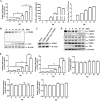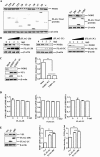Foot-and-Mouth Disease Virus Antagonizes NOD2-Mediated Antiviral Effects by Inhibiting NOD2 Protein Expression
- PMID: 30894473
- PMCID: PMC6532107
- DOI: 10.1128/JVI.00124-19
Foot-and-Mouth Disease Virus Antagonizes NOD2-Mediated Antiviral Effects by Inhibiting NOD2 Protein Expression
Abstract
The role of nucleotide-binding oligomerization domain 2 (NOD2) in foot-and-mouth disease virus (FMDV)-infected cells remains unknown. Here, we showed that FMDV infection activated NOD2-mediated beta interferon (IFN-β) and nuclear factor-κB (NF-ĸB) signaling pathways. NOD2 inhibited FMDV replication in the infected cells. FMDV infection triggered NOD2 transcription, while it reduced the abundance of NOD2 protein. Our results revealed that FMDV 2B, 2C, and 3C proteinase (3Cpro) were responsible for the decrease in NOD2 protein levels. 3Cpro is a viral proteinase that can cleave multiple host proteins and limit protein synthesis. Our previous studies determined that FMDV 2B suppressed protein expression of RIG-I and LGP2. Here, we found that 3Cpro and 2B also decreased NOD2 expression. However, this is the first report that 2C induced the reduction of NOD2 protein levels. We determined that both 2B- and 2C-induced decreases in NOD2 were independent of the cleavage of host eukaryotic translation initiation factor 4 gamma (eIF4G), induction of cellular apoptosis, or proteasome, lysosome, and caspase pathways. The interactions between NOD2 and 2B or 2C were observed in the context of viral infection. The carboxyl-terminal amino acids 105 to 114 and 135 to 144 of 2B were essential for the reduction of NOD2, while the residues 105 to 114 were required for the interaction. Amino acids 116 to 260 of the carboxyl terminus of 2C were essential for the interaction, while truncated 2C mutants did not reduce NOD2. These data suggested novel antagonistic mechanisms of FMDV that were mediated by 2B, 2C, and 3Cpro proteins.IMPORTANCE NOD2 was identified as a cytoplasmic viral pattern recognition receptor in 2009. Subsequently, many viruses were reported to activate NOD2-mediated signaling pathways. This study demonstrated that FMDV infection activated NOD2-mediated IFN-β and NF-ĸB signaling pathways. Host cells have developed multiple strategies against viral infection; however, viruses have evolved many strategies to escape host defenses. FMDV has evolved multiple mechanisms to inhibit host type I IFN production. Here, we showed that NOD2 suppressed FMDV replication during viral infection. FMDV 2B, 2C, and 3Cpro decreased NOD2 protein expression by different mechanisms to promote viral replication. This study provided new insight into the immune evasion mechanisms mediated by FMDV and identified 2B, 2C, and 3Cpro as antagonistic factors for FMDV to evade host antiviral responses.
Keywords: 2B; 2C; FMDV; NOD2; antagonistic mechanism.
Copyright © 2019 American Society for Microbiology.
Figures








Similar articles
-
Foot-and-Mouth Disease Virus Viroporin 2B Antagonizes RIG-I-Mediated Antiviral Effects by Inhibition of Its Protein Expression.J Virol. 2016 Nov 28;90(24):11106-11121. doi: 10.1128/JVI.01310-16. Print 2016 Dec 15. J Virol. 2016. PMID: 27707918 Free PMC article.
-
Foot-and-mouth disease virus 3C protease cleaves NEMO to impair innate immune signaling.J Virol. 2012 Sep;86(17):9311-22. doi: 10.1128/JVI.00722-12. Epub 2012 Jun 20. J Virol. 2012. PMID: 22718831 Free PMC article.
-
3Cpro of foot-and-mouth disease virus antagonizes the interferon signaling pathway by blocking STAT1/STAT2 nuclear translocation.J Virol. 2014 May;88(9):4908-20. doi: 10.1128/JVI.03668-13. Epub 2014 Feb 19. J Virol. 2014. PMID: 24554650 Free PMC article.
-
Evading the host immune response: how foot-and-mouth disease virus has become an effective pathogen.FEMS Immunol Med Microbiol. 2008 Jun;53(1):8-17. doi: 10.1111/j.1574-695X.2008.00409.x. Epub 2008 Apr 8. FEMS Immunol Med Microbiol. 2008. PMID: 18400012 Review.
-
Molecular Mechanisms of Foot-and-Mouth Disease Virus Targeting the Host Antiviral Response.Front Cell Infect Microbiol. 2017 Jun 13;7:252. doi: 10.3389/fcimb.2017.00252. eCollection 2017. Front Cell Infect Microbiol. 2017. PMID: 28660175 Free PMC article. Review.
Cited by
-
DDX21, a Host Restriction Factor of FMDV IRES-Dependent Translation and Replication.Viruses. 2021 Sep 3;13(9):1765. doi: 10.3390/v13091765. Viruses. 2021. PMID: 34578346 Free PMC article.
-
Use of IFN-Based Biotherapeutics to Harness the Host Against Foot-And-Mouth Disease.Front Vet Sci. 2020 Aug 11;7:465. doi: 10.3389/fvets.2020.00465. eCollection 2020. Front Vet Sci. 2020. PMID: 32851039 Free PMC article. Review.
-
GRP78 recognizes EV-F 3D protein and activates NF-κB to repress virus replication by interacting with CHUK/IKBKB.J Virol. 2024 Jun 13;98(6):e0026824. doi: 10.1128/jvi.00268-24. Epub 2024 May 22. J Virol. 2024. PMID: 38775480 Free PMC article.
-
Foot-and-Mouth Disease Virus: Molecular Interplays with IFN Response and the Importance of the Model.Viruses. 2022 Sep 27;14(10):2129. doi: 10.3390/v14102129. Viruses. 2022. PMID: 36298684 Free PMC article. Review.
-
Foot-and-mouth disease virus VP1 degrades YTHDF2 through autophagy to regulate IRF3 activity for viral replication.Autophagy. 2024 Jul;20(7):1597-1615. doi: 10.1080/15548627.2024.2330105. Epub 2024 Mar 22. Autophagy. 2024. PMID: 38516932 Free PMC article.
References
-
- Moffat K, Howell G, Knox C, Belsham GJ, Monaghan P, Ryan MD, Wileman T. 2005. Effects of foot-and-mouth disease virus nonstructural proteins on the structure and function of the early secretory pathway: 2BC but not 3A blocks endoplasmic reticulum-to-Golgi transport. J Virol 79:4382–4395. doi:10.1128/JVI.79.7.4382-4395.2005. - DOI - PMC - PubMed
-
- Moffat K, Knox C, Howell G, Clark SJ, Yang H, Belsham GJ, Ryan M, Wileman T. 2007. Inhibition of the secretory pathway by foot-and-mouth disease virus 2BC protein is reproduced by coexpression of 2B with 2C, and the site of inhibition is determined by the subcellular location of 2C. J Virol 81:1129–1139. doi:10.1128/JVI.00393-06. - DOI - PMC - PubMed
-
- Moraes MP, Segundo FD, Dias CC, Pena L, Grubman MJ. 2011. Increased efficacy of an adenovirus-vectored foot-and-mouth disease capsid subunit vaccine expressing nonstructural protein 2B is associated with a specific T cell response. Vaccine 29:9431–9440. doi:10.1016/j.vaccine.2011.10.037. - DOI - PubMed
Publication types
MeSH terms
Substances
LinkOut - more resources
Full Text Sources

